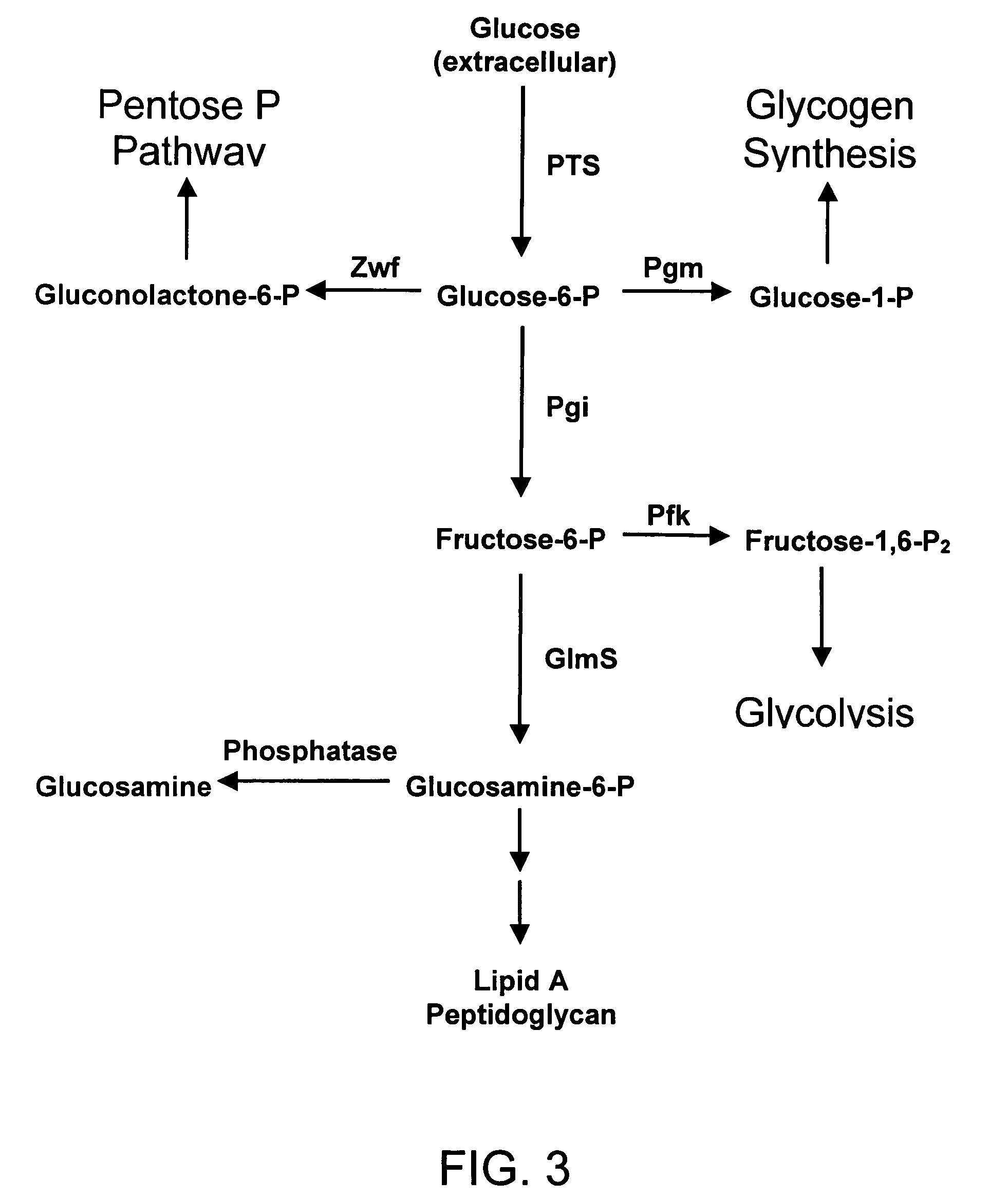Process and materials for production of glucosamine and N-acetylglucosamine
a technology of glucosamine and n-acetylglucosamine, which is applied in the direction of enzymology, peptides, and transferases, can solve the problems of low yield and energy, low yield of glucosamine salts, and significant erosion of the world market price of glucosamine, and achieves the effects of increasing the activity of glucosamine-6-phosphate acetyltransferase, increasing the activity of glu
- Summary
- Abstract
- Description
- Claims
- Application Information
AI Technical Summary
Problems solved by technology
Method used
Image
Examples
example 1
[0288]The following example describes mutant screening for better glucosamine producers.
[0289]U.S. Pat. No. 6,372,457, incorporated herein by reference in its entirety, described recombinant E. coli strains that produce glucosamine at high levels. These strains were constructed using a metabolic engineering approach. This approach is consisted of three steps. This first step was to introduce mutations that restrict metabolism and import of glucosamine and its 6-phosphate derivative. The second step was to over-express the E. coli glmS gene coding for glucosamine synthase (GlmS), the key biosynthetic enzyme. The third step was to minimize product inhibition of the GlmS by in vitro mutagenesis of the enzyme. The recombinant strain 2123-54 contained a product-resistant recombinant E. coli glmS mutant gene under T7 promoter control and showed the highest product titer in shake flask culture in a simple mineral salt medium supplemented with glucose. This strain was used as a reference to...
example 2
[0301]The following example describes over-expressing different glmS genes for glucosamine production.
[0302]Bacterial glucosamine synthase genes (glmS) and the yeast homologues (GFA genes) were cloned and expressed in E. coli to demonstrate their utility in glucosamine metabolic pathway engineering. Different genes were amplified from Bacillus subtilis, Saccharomyces cerevisiae and Candida albicans by PCR and placed under T7 promoter control in the expression vector pET24d(+). The constructs were transformed into the E. coli strain 7101-17(DE3) and maintained as free replicating plasmids. Additionally, the C. albicans GFA1 gene driven by the T7 promoter was integrated in the chromosome at the lacZ site in 7101-17 (DE3). Strains hosting different glmS and GFA genes were evaluated for gene expression and glucosamine production using IPTG induction.
B. subtilis glmS Gene Cloning:
[0303]The B. subtilis glmS gene contains an open reading frame of 1803 bp and encodes a protein of about 65 k...
example 3
[0320]The following example shows the characterization of different product-resistant GlmS enzymes: E. coli GlmS mutants and wild type B. subtillus GlmS.
[0321]Different glucosamine synthetase enzymes, including native B. subtillus GlmS, native E. coli GlmS and mutant E. coli GlmS, were studied in vitro. Cells of various E. coli strains were grown in the M9A medium, harvested, and frozen. Cells extracts were prepared and the glucosamine synthetases were characterized and compared. The DNA sequences were determined for two additional E. coli glmS mutants that showed strong product resistance and led to high glucosamine production in recombinant E. coli.
Sensitivity to Inhibition by Glucosamine-6-P:
[0322]Enzyme sensitivities to the reaction product glucosamine-6-P were examined. Initial velocity was examined at saturating glutamine and fructose-6-phosphate levels over a range of 0-30 mM glucosamine-6-P. Exemplary results are shown in FIGS. 4 and 5. The E. coli native GlmS enzyme from t...
PUM
| Property | Measurement | Unit |
|---|---|---|
| temperature | aaaaa | aaaaa |
| pH | aaaaa | aaaaa |
| pH | aaaaa | aaaaa |
Abstract
Description
Claims
Application Information
 Login to View More
Login to View More - R&D
- Intellectual Property
- Life Sciences
- Materials
- Tech Scout
- Unparalleled Data Quality
- Higher Quality Content
- 60% Fewer Hallucinations
Browse by: Latest US Patents, China's latest patents, Technical Efficacy Thesaurus, Application Domain, Technology Topic, Popular Technical Reports.
© 2025 PatSnap. All rights reserved.Legal|Privacy policy|Modern Slavery Act Transparency Statement|Sitemap|About US| Contact US: help@patsnap.com



